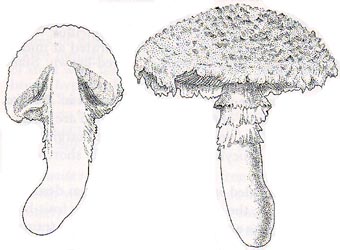|
[ Section Lepidella page. ]
[ Amanita Studies home. ]
[ Keys & Checklist/Picturebooks ]
Technical description (t.b.d.) BRIEF DESCRIPTION: The cap of A. roseolescens is 100 - 160 mm wide, semiglobate to convex, thick fleshed, white to pale ochraceous, with a slight pink tinge, dry, fibrillose-subsquamulose with squamulose center with age, appendiculate, with a nonsulcate margin. The flesh is white turning pinkish buff. The gills are crowded, free, broad, at first white, and later pink to pinkish buff. The short gills are attenuate. The stem is 100 - 140 x 15 - 30 mm, equal or slightly enlarged below, solid, pinkish white to pinkish buff, with thick, lanose-squmose covering especially at the middle. The spores measure 9 - 11 (-12) x 8 - 10 (-10.5) Ám and are amyloid and globose to broadly ellipsoid. Clamps are present at bases of basidia. Amanita roseolescens was originally described from South Africa. It is still known only from that country. It is one of the taxa of section Lepidella that occur without the presence of any woody plant symbiont. The most similar taxa are A. foetidissima D. A. Reid & Eicker nom. inval., <1>A. manicata (Berk. & Broome) Pegler, and A. nauseosa (Wakef.) D. A. Reid in Bas' stirps Nauseosa. -- R. E. Tulloss Drawing: Dr. C. Bas (1969) (South Africa, reproduced by courtesy of Persoonia, Leiden, the Netherlands)
[ Section Lepidella page. ]
[ Amanita Studies home. ]
[ Keys & Checklist/Picturebooks ] Last changed 19 March 2009. |
